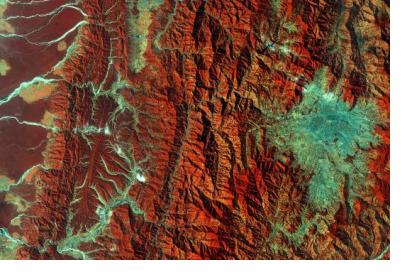On 12 March, Nepal Telecommunications Authority (NTA) signed an agreement with French satellite operator Thales Alenia Space to build Nepal’s first communications satellite. The Nepalese government intends to use the satellite to provide nationwide internet access to its citizens, improve disaster management efforts and strengthen economic growth in the country.
The development of Nepal’s own satellite system proves to be significant in terms of improving the country’s disaster management efforts. Nepal is regularly faces natural disasters such as droughts, floods, landslides, fires, and storms as well as earthquake due to its high-seismicity. The mountainous landscape contributes to the challenges to improving the country’s transportation and utilities sector. Recently, one of UN-SPIDER’s Regional Support Offices, the International Centre for Integrated Mountain Development (ICIMOD), published the first assessment of the Hindu Kush Himalaya region, which was written by over 300 researchers, experts and policymakers.
The official contract between Thales Alenia Space and NTA is expected to be signed in the upcoming month. The agreement was drafted in response to negotiations between Nepal and France concerning Nepal’s endeavor to set up a national communication satellite. Nepal’s Minister for Communication and Information Technology, Gokul Prasad Baskota, and the Secretary to the Minister for Europe and Foreign Affairs, Jean-Baptiste Lemoyne, signed a letter of intent on 5 March in Paris.
The French government will increase its financial and technical support for Nepal in establishing the latter’s national satellite project. This includes helping with materializing plans to operate and manage Nepal’s satellite in the orbital slot allotted by the International Telecommunications Union (ITU). According to Head of the Security Printing division under the Ministry of Information and Communications, Bikal Poudel, Nepal hasn’t been able to construct its own satellite project due to lack of needed technical and financial assistance.
Telecommunication satellites in Asia
The high-performance C and Ku Band satellite, which will be named by Nepal, will be launched by 2022 and positioned at orbital slot an 123.3 degrees East. Satellites with C or Ku band, such as those of the AsiaSat fleet covering Asia and partially Australasia, are primarily used for satellite communication.
Nepal has no domestic satellite operator but is covered by regional satellite operators of other Asian countries such as Thaicom of Thailand or Malaysia’s Measat. With the eventual launch of the satellite system, NTA aims to provide access to high-speed internet and to advancements in value-added services such as telemedicine, TV broadcasting, tourism, hydropower and disaster management.
“To successfully compete with other countries, to give high speed internet to all our citizens and to be recognized regionally, we want Nepal to accelerate its pace on the way to digitization,” Minister for Communication and Information Technology of Nepal Gokul Prasad Baskota stated. “No one must be left behind on this path. Our National Satellite will help us jump into a better future.”
Many Asian countries have entered the market of establishing national satellites. Lao People’s Democratic Republic launched their first satellite in 2015 and Bangladesh sent Bangabandhu-1, also built by Thales Alenia Space, into orbit last April.

